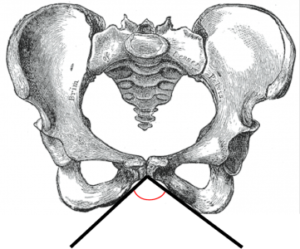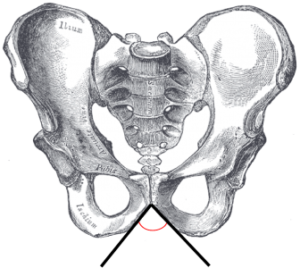By SUE COLETTA
I’ve seen way too many medical professionals in the last six months (living with rheumatoid and psoriatic arthritis isn’t always easy). As Joe pointed out Saturday—beautifully, I might add—life as we know it can change in an instant. In short, remember to have fun. Laughter really is the best medicine.
One way I’ve amused myself while waiting in the exam room is by analyzing the skeleton suspended by a metal pole. You know the one … the staff usually names it Fred, or something equally common, as though the name will somehow lessen the impact of bad news.
What I find fascinating is the fact that the vast majority of doctors and nurses don’t know the sex of their skeleton, evident by the female skeletons tagged with a male name.
Determining the Sex of a Skeleton
Many differences exist between the two sexes, and the variations run as deep as our bones. This becomes especially important for corpses found in an advanced stage of decomposition. All that might remain is the skeleton, perhaps teeth, and possibly some hair. Even if the pathologist has teeth and hair to work with, that doesn’t mean enough DNA material remains to identify the victim.
This is where the skeleton offers more information. The only exception would be that of a pre-adolescent, where sexual dimorphism is slight, making the task much more difficult. Need to buy time in your story? Murder an adolescent. (Oh, no, she didn’t just say that.) Or have the killer shatter the key areas of the skeleton.
The most common way to determine a skeleton’s sex is by bone size. Not the most accurate, but it’s a starting point. Male bones are generally larger than female bones because of the additional muscle that increases on the male through adolescence and into adulthood.
Another good inclination of sex is the pelvic area.
The sub-pubic angle (or pubic angle) is the angle formed at pubic arch by the convergence of the inferior rami of the ischium (loop bone at the base) and pubis (top of loop) on either side. Generally, the sub-pubic angle of 50-60 degrees indicates a male. Whereas an angle of 70-90 degrees indicates a female. Women have wider hips to allow for childbirth.

Female

Male
There are also distinctive differences between the pubic arches in males and females. A woman’s pubic arch is wider than a male’s as is the pelvic inlet to allow a baby’s head to pass through.
The pubic arch is also referred to as the ischiopubic arch. Incidentally, this difference is noticed in all species, not just humans.
The area around the pelvic inlet (middle of the pelvic bone) is larger in females than in males. A female skeleton who has given birth naturally will be identifiable because this space widens during childbirth. Even though it contracts afterward, it never fully returns to its original size. In the picture above notice the heart-shaped space.
If you don’t want the pathologist to easily ID the victim, perhaps the neighborhood bear takes off with the pelvis bone. You could also have him return for the rest of the body as the coroner is examining the corpse. Talk about adding conflict to the scene! Just remember, most black bears don’t eat human flesh (in my area, anyway). So, do your homework. Grizzly bear, anyone? How about a Kodiak brown bear?
Other Body Clues
The acetabulum—the socket where the femur (thigh bone) meets the pelvis—is larger in males. Also, the head and skull have several characteristics that help the pathologist (or crime writer) determine male from female.
- In males, the chin is squarer. Females tend to have a slightly more pointed chin.
- The forehead of males slant backward, where females have a slightly more rounded forehead.
- Males tend to have brow ridges; females do not.
These differences and more tell the pathologist the sex of the deceased.
So, the next time you’re sitting in an exam room, get friendly with the skeleton in the room. Who knows? You may even sell a book or two when you educate the staff. Do it nicely, though. Some medical professionals don’t like to be schooled by a crime writer, as weird as that sounds. 🙂
Wishing you all a joyous Thanksgiving!

I had some “fun” with this while working on “Deadly Bones” where a dog finds a humerus. I learned that any bone discovered, especially if it might be human, means a call to the coroner’s office, and that even my Animal Control officer would know to leave it in place and not drop it on the Police Chief’s desk. I learned deer bones are often confused with human bones.
I spoke with the county coroner’s office, and the man was very helpful, and kept trying to give me ways to ID the body — find the skull, send it to Texas — but I wanted my cops to glean as little information as possible from the single bone. (Make sure animals chew off the ends so height and age can’t be determined.)
My doctor’s office doesn’t have a skeleton in any of the rooms I’ve been in, but my massage therapist has one.
Oooh, great information about deer, Terry. Thanks for sharing. Wildlife chewing off the ends of a bone is a perfect way to delay identification. You go, girl! Love it when writers take the time to research. The hard work pays off in the finished product.
Great info, Sue, thanks.
You betcha, Priscilla. My pleasure.
Thanks for another fun blog, Sue, and here’s hoping you never see another medical skeleton. My PT has a skeleton who wears a Santa hat all year long. I’ll have to find out his sex.
I’ll cheers to that, Elaine. Your physical therapist could have Mrs. Claus!
Fascinating. Gives me something to look forward to the next time I visit my doctor.
Haha. Right? We need to find ways to amuse ourselves in an otherwise dull surrounding. 🙂
This was very interesting thanks for sharing! Hope you feel better by the way. ?
Thanks, Cindy! I’m way too stubborn to let it beat me. 🙂
I had always heard that males have squarer jaw bones.
My day job is at a medical assistant school. We have skeletons all over the place. One day I went by the front desk. There was a stack of boxes all marked HUMAN SKELETON in big letters. Always a fun time for first time visitors. We do a great Halloween.
Hahahaha. I bet you do, Alan!
I’m surprised that human skeletons are actually used in doctor offices with the qualtiy of the replicas these days. I’ve been to a lot of doctor offices over the years since I took care of my mom in her final years, but I can’t say that I’ve seen one, ever.
I’m referring to replicas, Marilynn, but since they’re anatomically correct, you can still find the differences between the two sexes. 🙂
Have done a lot of research over the years on skeletons…they provide great clues! We had a baby skull in our book Island of Bones, and a young cop (whose wife just had a baby) tells our hero Louis that he can tell it’s a newborn because there are spaces between the three bones that make up the baby’s head — called fontanelles. These gaps don’t disappear and the skull doesn’t completely ossify in to one piece until between 10 and 24 months.
Fantastic information, Kris! I may need to refer back to your comment for my WIP. My skull is a little older, but it gives me a good starting point. Thanks for sharing. 🙂
Pingback: Top Picks Thursday! For Writers & Readers 11-22-2018 | The Author Chronicles